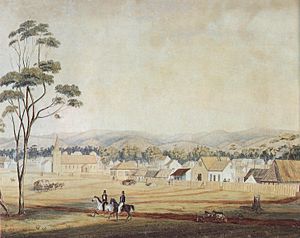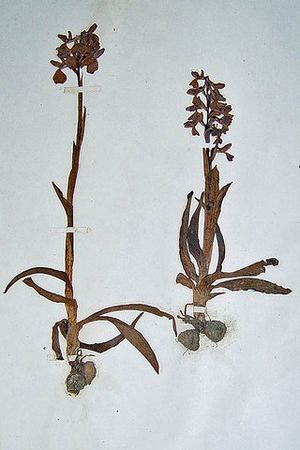Joseph Whittaker (botanist) facts for kids
Quick facts for kids
Joseph Whittaker
|
|
|---|---|
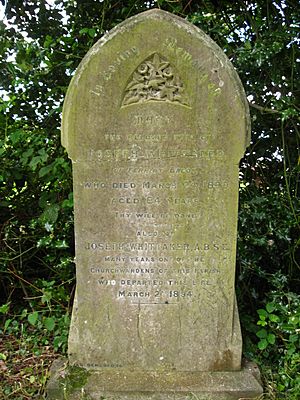
Joseph Whittaker gravestone, Derbyshire
|
|
| Born | 1813 Breadsall
|
| Died | 1894 |
| Nationality | British |
| Education | nurseryman |
| Occupation | schoolmaster, nurseryman |
| Known for | Flora of Australia, Flora of Derbyshire |
| Spouse(s) | Mary |
Joseph Whittaker (1813 – 1894) was a British Botanist who visited South Australia in 1839. 300 plants in Kew Gardens are the collection which Whittaker made during that trip. And 2,200 pressed British plants in Derby Museum and Art Gallery are also Whittaker's.
Early Days
Whittaker's exact birth date is not known. He was christened at Quarndon near Derby on 8 February 1813. His father was also named Joseph, and was a labourer who married to Sarah (born Clarke). The son is sometimes reported as being born in Breadsall in 1815.
Australian Botany
In 1838 Whittaker went on a voyage to Austratia as a "gardener". His new employer was Lt. Col. George Gawler who had recently been appointed as the second Governor of South Australia. Whittaker, seven other employees from Derbyshire, Gawler and his wife and children arrived on the Pestonjee Bomanjee on 12 October 1838 in Adelaide. They had traveled for four months via Rio de Janeiro. When Whittaker and Gawler arrived they found poor conditions so gardening was not important.
Whittaker collected plants around Adelaide in South Australia in 1839-40. Whittaker traveled to places within South Australia where he collected a wide range of plant samples. These included Mount Lofty range, Mount Jagged, River Torrens, River Murray and the Hindmarsh River. Whittaker was the first person to collect from the mountainous district of the Fleurieu Peninsula, Encounter Bay and Mount Barker.
Whittaker stayed in South Australia for nineteen months before sailing home on the Katherine Stuart Forbes which left from Port Adelaide on 11 April 1840. On the way home his boat stopped four times at Kangaroo Island, Mauritius, St Helena and Corvo Island in the Azores. Whittaker collected further plant samples while the boat was in these harbours.
Derbyshire Botany
Whittaker arrived back in England on 23 September 1840 and by 1844 had begun collecting plants again. His activity peaked in 1851 and 52, ceasing sometime after 1867. He collected from many parts of Derbyshire, but he occasionally traveled outside the county including Bulwell, Nottinghamshire, Rhyl and Denbigh in Wales.
By 1846 he was living at Breadsall in Derbyshire where he was a teacher at Breadsall Boys School. From here he exchanged letters with Sir William J. Hooker Director of the Kew Botanic Gardens. Because Whittaker had planed to write a number of books on British botany, and needed to exchange some of his Australian and related samples for that. Whittaker collected about 300 plants that were eventually acquired by Kew. Whittaker's collections from outside the U.K. are now in Kew Gardens. Whittaker had the species of sundew Drosera whittakeri named after him.
In February 1847 Whittaker became a member of the Botanical Society of London and he swapped plant samples between 1849 to 1853 with its members. He then joined the Botanical Exchange Club and finally the Botanical Locality Record Club. By 1847 he had enough information to publish “a list of rare plants found in the neighbourhood of Breadsall, Derbyshire”. This contained a mixture of both rare and relatively common species, and gives a good information of the botanical variety of the area at that time. In 1857 he was the schoolmaster of ninety children at Breadsall in Derbyshire, a village whose inhabitants included the naturalists Rev. Henry Harpur Crewe and Francis Darwin. The school was funded by the Harpur-Crewe family.
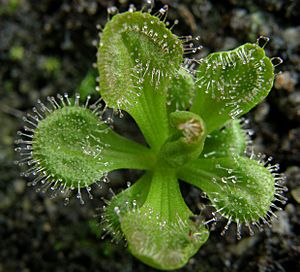
Whittaker lived in the small village of Morley near Derby in the late 1850s. He lived with his wife Mary in the house named Ferriby Brook. He continued to teach there, taking up to twelve scholars into his classes, usually after they had left the local school, and were between eight and eighteen years of age. He eventually established a large collection of living plants. Local gardener groups reported that he was growing over 1,300 different species. By 1871 he quit being a schoolmaster, and became a “seedsman and florist”. By 1881 successfully became a “nurseryman and farmer”.
Whittaker died on 2nd March 1894. By popular subscription, a memorial reading desk and engraved brass inscription were built for St Matthew's Church, Morley, where he was a church warden and where he was buried.
Legacy
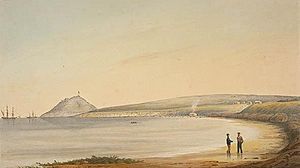
Whittaker's collection at Kew Gardens is from his trip to Australia and from ports where he stayed shortly during the way home. He also left a collection of 2,200 pressed plants in 79 volumes, mostly from Derbyshire, which are now held in the herbarium at Derby Museum and Art Gallery. They provide important evidential samples for local studies on the flora of Derbyshire. Due to his participation in botanical exchanges clubs, there are now Whittaker samples in many UK museum collections, including those at Bolton, Birmingham, Gloucester and Manchester. The Wisbech and Fenland Museum also has a small collection.
Images for kids


